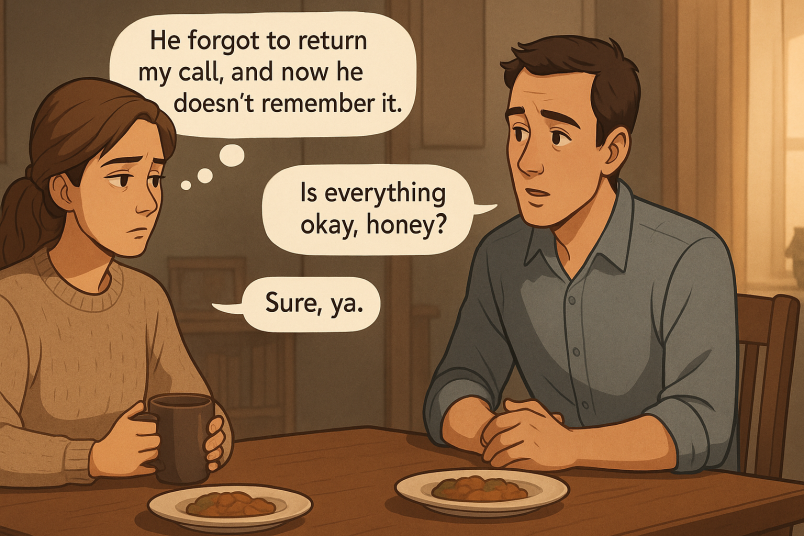What Is Passive Aggressive in Relationships: Types & Impact

Unlock Daily 30-Sec Tips for a Happier Relationship
👉 Subscribe FREEKey Takeaways
Marriage.com AI Quick Summary
“I’m fine…” she says, with that half-smile you’ve seen before; he nods, pretending to believe it, but the air feels heavier somehow.
“Did I do something?” he asks, and she shrugs—no argument, yet no warmth either.
Later, he finds the dishwasher half-empty, the laundry basket untouched, and little unspoken messages scattered through the day. It’s not shouting or slamming doors—it’s quieter, slower, but it lingers. In these moments, the dance of feelings and silence can be more exhausting than a fight.
This is where things turn passive-aggressive; words hide, emotions simmer, and the real conversation waits just out of reach.
What is passive-aggressive in relationships?
In relationships, passive-aggressive means expressing negative feelings indirectly rather than openly communicating them. Instead of addressing concerns honestly, a person may use sarcasm, subtle digs, procrastination, or withdrawal to convey frustration. This behavior often creates confusion, tension, and emotional distance between partners.
For example: Imagine one partner feeling upset because the other forgot an important date. Instead of saying, “I’m hurt you forgot,” they give short replies, avoid eye contact, and “forget” to do something the other cares about. This indirect approach leaves the real issue unresolved while building resentment.
Please note:
If you recognize these patterns, remember—it doesn’t mean your relationship is doomed. Understanding what does passive aggressive mean is the first step; with honest dialogue and patience, couples can replace silent resistance with mutual trust and understanding.
5 causes of passive-aggressive behaviour
Passive-aggressive behaviour often stems from unspoken frustration, fear of direct conflict, or learned communication patterns. It hides resentment behind subtle actions or words, making it harder to address problems openly and build genuine understanding.
Passive aggression often stems from deeper psychological issues. According to a study published in the Journal of Personality and Social Psychology, passive aggression often stems from an inability to regulate negative emotions and express dissatisfaction constructively.
Some of the key causes include:
1. Fear of confrontation
People who avoid conflict might resort to passive-aggressive behaviors to express anger without risking open confrontation.
2. Low self-esteem
Insecurity can lead individuals to hide their emotions, fearing rejection or judgment if they’re honest about their feelings.
3. Unresolved anger
Past experiences of being ignored or invalidated can make people channel their frustration into passive-aggressive actions.
4. Cultural or social conditioning
Societal norms that discourage the direct expression of negative emotions may push individuals toward indirect behaviors.
5. Lack of communication skills
Difficulty expressing thoughts and emotions clearly can cause individuals to rely on subtle, indirect actions instead of addressing issues openly and constructively.
3 types of passive-aggressive behaviors in relationship dynamics
In relationship dynamics, passive-aggressive behaviors often surface in subtle yet damaging ways. They disguise frustration or resentment behind indirect actions, creating confusion, eroding trust, and making it harder for partners to address issues head-on.
1. Passive aggression in romantic relationships
Passive aggression can subtly sabotage the trust and intimacy that are essential in romantic relationships. This behavior often manifests in covert ways that, over time, create emotional distance and conflict.
A study published in the Journal of Social and Personal Relationships found that passive aggression in romantic relationships is strongly linked to dissatisfaction and conflict avoidance.
-
Common signs & examples
One of the clearest signs of passive aggression is withholding affection or communication, especially after disagreements. Instead of addressing issues directly, a partner might become distant or unresponsive, leaving the other person to guess what went wrong.
A research paper published in the Journal of Social and Personal Relationships states that open communication is linked to lower relationship distress initially, and predicts greater satisfaction over time.
Another form of passive aggression is subtle criticism masked as humor. For instance, a sarcastic remark like, “I guess that’s your idea of cleaning,” can convey frustration while avoiding an outright confrontation.
Similarly, procrastinating on shared responsibilities—whether it’s delaying plans or avoiding household tasks—signals underlying resentment or dissatisfaction. These behaviors may seem minor, but they carry significant emotional weight.
-
The impact
Passive aggression in romantic relationships breeds resentment and mistrust. Unspoken emotions fester, creating tension and distance. Over time, the affected partner may feel unloved or invalidated, weakening the relationship’s foundation and making conflicts harder to resolve.
-
How to address
Dealing with passive-aggressive behavior starts with open and honest communication. It’s crucial to create an environment where both partners feel safe expressing their feelings without fear of judgment. Encourage directness and validate emotions to foster mutual understanding.
Setting boundaries is another essential step. Clear expectations about acceptable behavior can prevent passive aggression from becoming a recurring pattern. For example, agreeing to address issues as they arise can reduce the likelihood of silent treatment or sarcastic remarks.
For deeply ingrained habits, seeking therapy or counseling is often the most effective approach. Professionals can provide strategies for overcoming passive aggression in relationships, helping both partners navigate their emotions and rebuild trust.
2. Passive aggression in familial relationships
Families often operate as complex emotional systems, where passive aggression can subtly yet deeply affect interactions. Unlike open conflicts, passive aggression in relationships with family members often involves indirect expressions of frustration or resentment. Left unchecked, it can create lasting emotional distance and unresolved tensions.
-
Common signs & examples
In many families, it comes up when parents express disappointment through guilt rather than direct discussion. Statements like “I guess I’ll just do it myself since no one cares enough to help me” are common examples. These remarks aim to elicit a response without openly addressing the underlying issue.
Sibling rivalry often provides fertile ground for passive-aggressive behaviors. Sarcastic comments such as “Nice job, as usual,” or indirect competition through one-upmanship are subtle ways siblings express frustration or jealousy.
Similarly, families may avoid difficult topics entirely, using silence or deflection instead of open communication. This avoidance perpetuates a cycle of unresolved emotions.
-
The impact
Passive aggression in family relationships can lead to significant emotional strain over time. Avoidance of direct conversations fosters a culture of miscommunication, where emotions are suppressed rather than resolved. This often results in long-term resentment, fractured relationships, and a lack of emotional intimacy among family members.
Generational passive-aggressive behaviors can also perpetuate these dynamics, as children often mimic the communication styles they observe in their parents. Over the years, unresolved conflicts can escalate, making reconciliation more challenging.
-
How to address
Dealing with passive-aggressive behavior within families starts with fostering honest and respectful communication. Encouraging open discussions about feelings, even when they’re uncomfortable, can help break the cycle of indirect conflict.
Another crucial step is addressing generational patterns. Family members must consciously avoid repeating the passive-aggressive habits they learned growing up. This might involve making an effort to be more transparent in expressing emotions or setting healthier communication boundaries.
For deeply entrenched issues, family mediation or counseling can be highly effective. A neutral third party can guide families in understanding their dynamics and provide strategies for resolving conflicts constructively.
3. Passive aggression in platonic relationships
Friendships are built on trust and mutual respect, but passive aggression can quietly erode these foundations. Unlike overt disagreements, passive aggression in relationships with friends often goes unnoticed until it causes significant damage.
-
Common signs & examples
Passive aggression among friends often manifests in subtle yet hurtful ways. One common example is making sarcastic or backhanded comments disguised as jokes. A friend might say something like, “Oh, you actually showed up this time!” after you arrive for plans, leaving you questioning their true intentions.
Another frequent behavior is agreeing to plans but repeatedly canceling at the last minute. While this may appear harmless, it often signals deeper issues like avoidance or dissatisfaction within the friendship.
Similarly, giving the silent treatment after a disagreement can be a passive-aggressive way of expressing anger without addressing the conflict directly.
-
The impact
Passive aggression in platonic relationships breeds tension and mistrust. Over time, these behaviors create emotional distance, making it difficult for friends to feel secure or valued in the relationship.
As misunderstandings pile up, the bond weakens, leaving both parties frustrated and disconnected. If unaddressed, passive aggression can turn even the closest friendships into toxic connections.
-
How to address
Dealing with passive-aggressive behavior in friendships requires open and supportive communication. Encourage honest conversations where both parties can express their feelings without fear of judgment.
Acknowledge the behavior constructively, saying something like, “I noticed you’ve been canceling plans lately. Is something bothering you?” This approach helps address the root cause without escalating the situation.
Recognizing and calling out passive-aggressive behaviors is crucial, but must be done with empathy. Avoid accusatory language, and focus on how the behavior impacts the relationship. If the issue persists and the friendship becomes emotionally draining, it may be time to reevaluate the connection.
Walking away from toxic friendships is a valid choice when repeated attempts at passive-aggressive conflict resolution fail.
5 signs to recognize passive-aggressive patterns
Whether it’s in romantic, familial, or platonic connections, understanding these patterns is crucial for improving communication and building healthier dynamics. Below are some key signs to watch for, followed by tips for self-reflection to determine if you might exhibit passive-aggressive tendencies yourself.
1. Subtle avoidance of conflict
A hallmark of passive-aggressive behavior is avoiding direct confrontation while expressing dissatisfaction indirectly. For instance, someone might agree to a plan they dislike but later act disinterested or disengaged, subtly signaling their disapproval.
- Example: Alex agrees to attend a family gathering but spends the evening scrolling on their phone, barely interacting with anyone.
2. Non-verbal cues
Actions often speak louder than words in passive aggression. Non-verbal cues such as eye-rolling, exaggerated sighing, or a sarcastic tone can communicate frustration without addressing the issue openly. These behaviors create tension without resolving the underlying conflict.
- Example: During a discussion about chores, Jamie rolls their eyes and smirks instead of expressing their disagreement.
3. Patterns of procrastination or passive resistance
Procrastination is another common form of passive-aggressive behavior. Whether it’s delaying tasks or intentionally doing them poorly, this behavior indirectly expresses resentment or resistance. For example, failing to complete shared responsibilities at home could signal dissatisfaction with the division of labor.
- Example: Taylor leaves the trash overflowing for days, knowing their partner asked them to take it out.
4. Backhanded compliments
Passive-aggressive communication can also take the form of disguised insults wrapped in compliments. While appearing polite, the underlying tone undermines the other person’s confidence or achievements.
- Example: “You actually did a good job this time,” Pat says with a forced smile after their partner finishes a task.
5. Withholding important information
Choosing not to share details that could prevent misunderstandings is another way to express silent disapproval or control. This keeps the other person guessing and adds unnecessary strain.
- Example: Morgan forgets to mention a change in dinner plans until the last minute, knowing it will cause inconvenience.
7 practical ways to deal with passive-aggressive behaviour in relationships
Preventing and overcoming passive aggression in relationships requires conscious effort, emotional growth, and effective strategies. Here are practical ways to address and eliminate passive aggression in relationships.
1. Building healthy communication skills
Developing effective communication is the foundation of any strong relationship. Practice expressing your feelings openly and assertively without resorting to confrontation or blame.
- How to start: Instead of keeping quiet, directly state, “I feel disappointed because my expectations weren’t met.” This approach fosters understanding and encourages problem-solving rather than creating distance.
2. Emotional intelligence
Improving emotional intelligence is crucial for overcoming passive-aggressive tendencies. Empathy and self-awareness allow you to understand your partner’s feelings and recognize your own behavioral patterns.
- How to start: Practice active listening by giving your partner your full attention, acknowledging their feelings, and showing empathy. This builds a safe space for honest conversations.
3. Setting boundaries
Clear boundaries help prevent passive aggression by reducing misunderstandings and unmet expectations. When both parties know what is acceptable and what isn’t, it’s easier to address issues directly.
- How to start: Be explicit about your needs and encourage your partner to do the same, ensuring mutual respect and clarity in the relationship.
4. Seeking professional help
Sometimes, overcoming passive aggression in relationships requires external support. Therapy provides a safe space to identify and address underlying issues fueling passive-aggressive behavior. Couples therapy can help both partners develop healthier communication strategies, while individual therapy can uncover personal triggers and fears contributing to the behavior.
- How to start: Research licensed therapists who specialize in relationships or communication issues, and schedule an initial session to discuss your concerns and goals openly with a professional.
5. Creating a positive relationship dynamic
Cultivating a relationship dynamic based on mutual respect and encouragement discourages passive-aggressive behaviors. Celebrate each other’s efforts, practice gratitude, and prioritize constructive feedback over criticism.
- How to start: Make a habit of acknowledging your partner’s efforts daily, express appreciation for small gestures, and replace critical remarks with specific, constructive suggestions that encourage growth and understanding.
Watch this TED Talk by Christina Costa, psychologist and well-being researcher, who shares how practicing gratitude can reshape our brain’s resilience and boost emotional health.
6. Addressing issues early
Tackling concerns as soon as they arise prevents resentment from building and reduces the likelihood of indirect expressions of frustration.
- How to start: When something bothers you, bring it up within a day or two, focusing on the behavior rather than criticizing the person.
7. Practicing self-reflection
Regular self-reflection helps you identify your own triggers, patterns, and contributions to conflict. Recognizing these can prevent passive-aggressive responses.
- How to start: Keep a journal of moments you feel frustrated, noting how you reacted and how you could respond more constructively next time.
FAQ
Understanding passive-aggressive behavior in relationships can be tricky. These quick answers address common concerns and help clarify how it affects communication, trust, and emotional connection.
-
Is passive-aggressive behavior always intentional?
Not always. Sometimes it’s a learned coping mechanism, and the person may not realize how their actions affect others.
-
Can cultural background influence passive-aggressive tendencies?
Yes. In cultures where direct confrontation is discouraged, people may express frustration indirectly.
-
Is passive-aggressive behavior linked to mental health conditions?
It can be associated with certain personality traits or disorders, but it isn’t classified as a standalone mental illness.
Breaking the cycle
Passive-aggressive behavior can quietly chip away at the closeness you share, but it doesn’t have to define your relationship. When you start noticing the signs and gently bring them into the open, you give both yourself and your partner a chance to feel heard and understood.
With patience, kindness, and a genuine commitment to clear communication, those small moments of frustration can turn into opportunities for connection. Every honest conversation, every bit of empathy, brings you closer to building a relationship where trust feels natural and love feels safe.
 Tips
Tips
Write your tip or submit a video tip
All tips are reviewed before the publishing.
Share this article on
Want to have a happier, healthier marriage?
If you feel disconnected or frustrated about the state of your marriage but want to avoid separation and/or divorce, the marriage.com course meant for married couples is an excellent resource to help you overcome the most challenging aspects of being married.
Recent Articles
Related Quizzes
Unlock Daily 30-Sec Tips for a Happier, Healthier Relationship
👉 Subscribe FREE on YouTube We'd love your feedback!
We'd love your feedback!
 Expert Q&A
Expert Q&A
Ask your question related to this topic & get the support you deserve from experts.



















 Thanks for your feedback!
Thanks for your feedback!